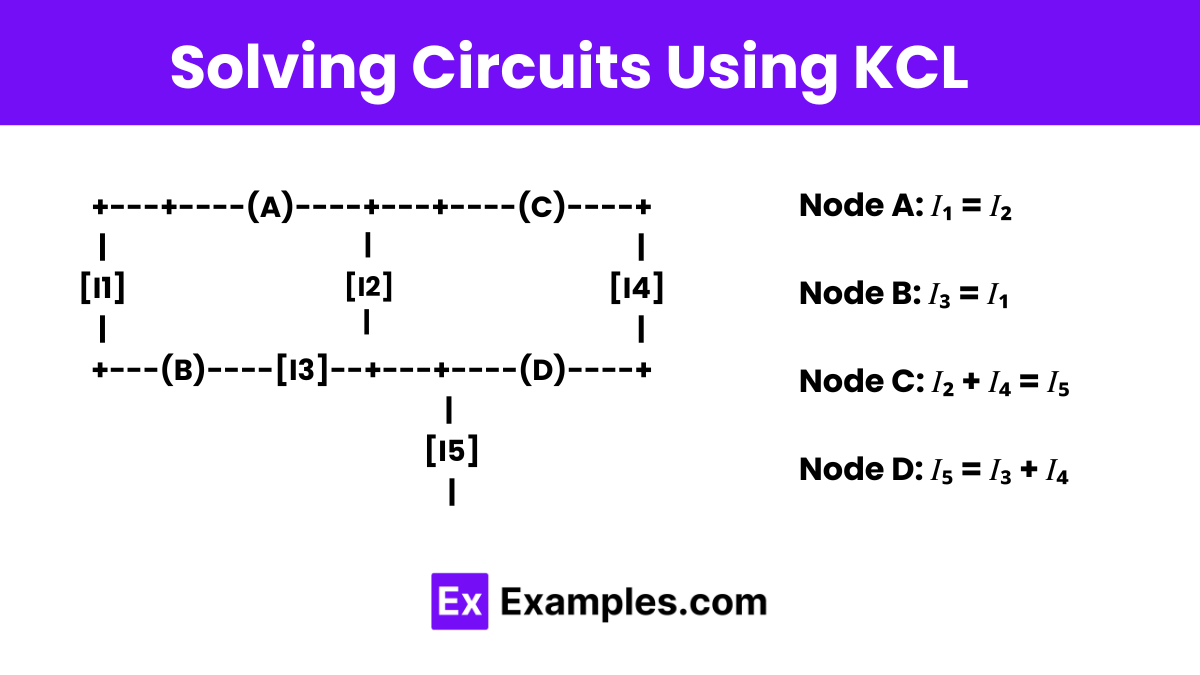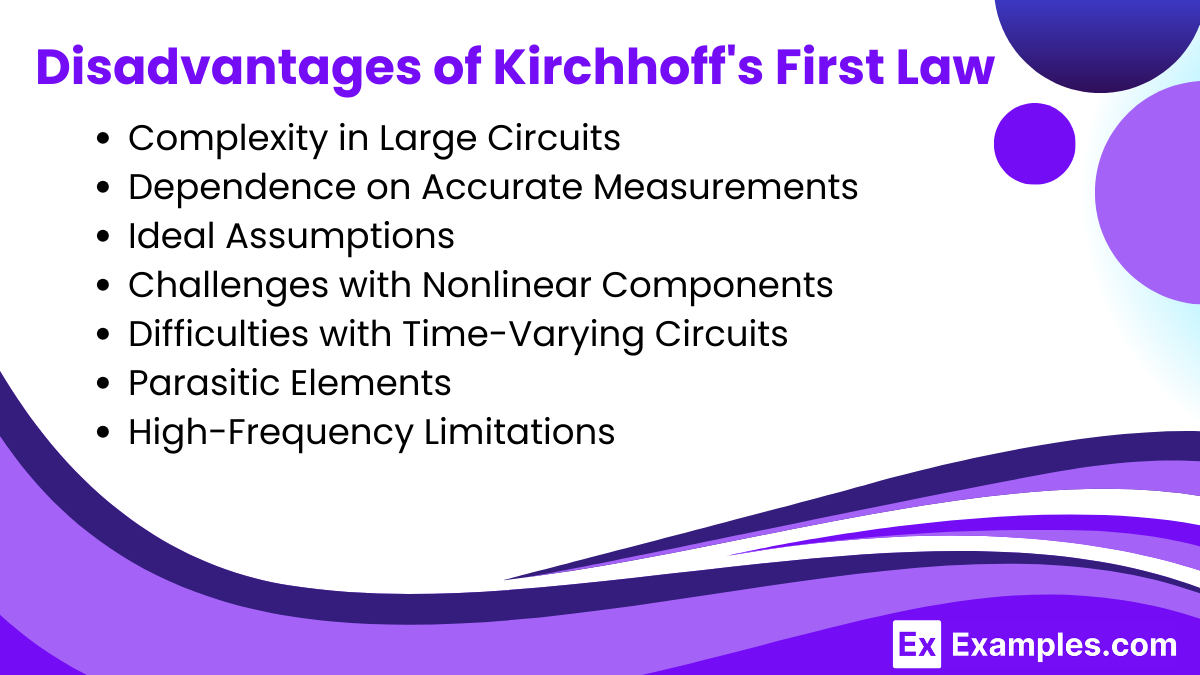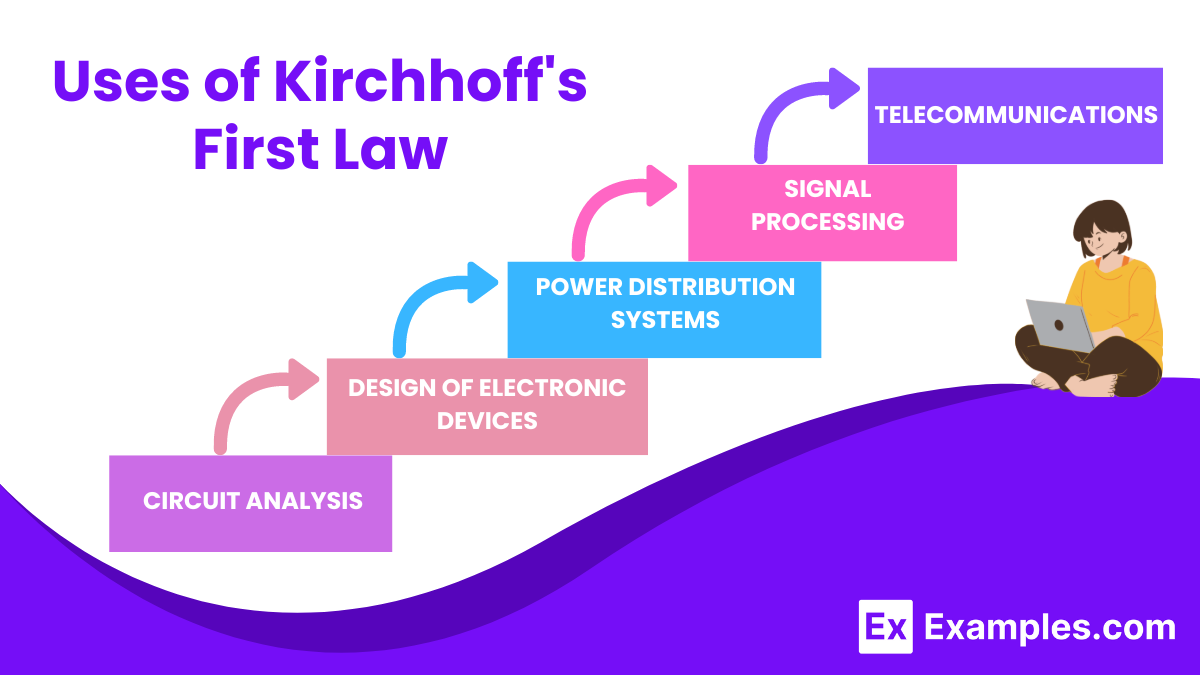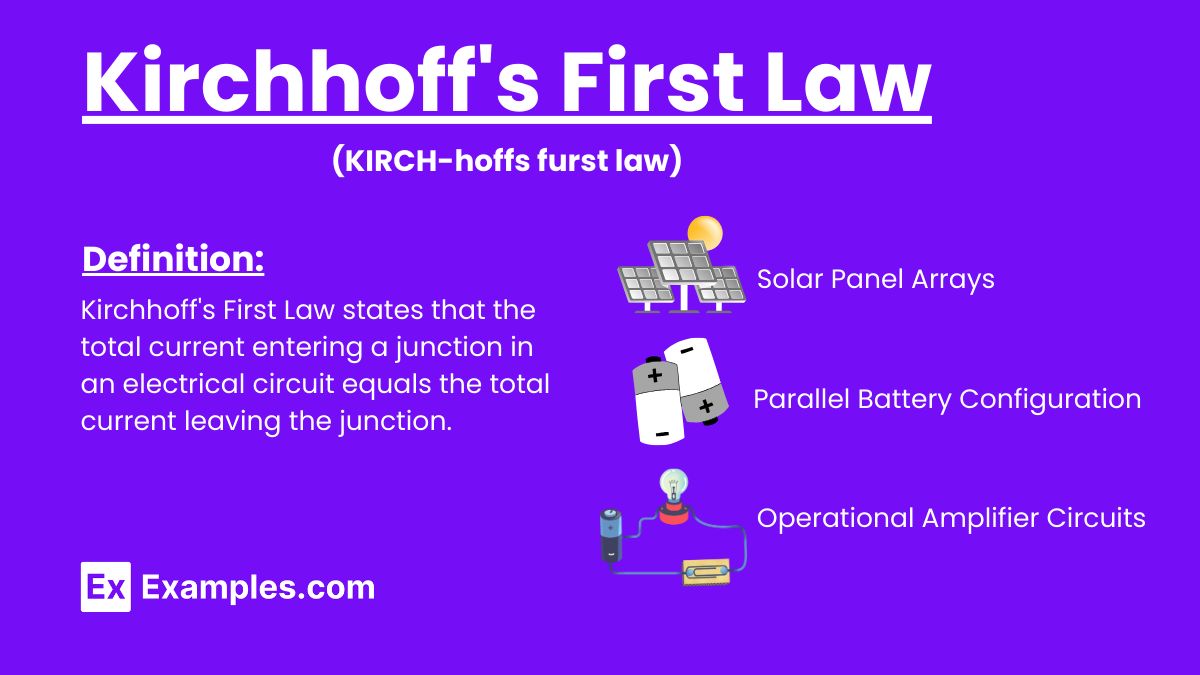Kirchhoff’s First Law
Kirchhoff’s First Law, also known as the Kirchhoff’s Current Law (KCL), is a fundamental principle in electrical circuit theory. It is the first law in Kirchhoff’s Circuit Laws. It states that the total current entering a junction in an electrical circuit equals the total current leaving the junction. This law is derived from the conservation of electric charge.
What is Kirchhoff’s First Law?
Kirchhoff’s First Law Formula
The formula for Kirchhoff’s First Law is given by:

Where:
- ∑ⁿₖ₌₁ 𝐼ₖ is the sum of all currents (𝐼ₖ) entering and leaving the node.
- n is the number of branches connected to the node.
- Currents entering the node are considered positive, and currents leaving the node are considered negative.
Solving Circuits Using KCL

Steps to Solve Circuits Using KCL:
- Identify Nodes: Determine all the nodes in the circuit.
- Choose a Reference Node: Select one node as the reference (ground) node. Assign voltages 𝑉₁,𝑉₂,…,𝑉𝑛 to the other nodes relative to this reference node.
- Apply KCL to Each Node: Write the KCL equation for each node (except the reference node) by setting the sum of currents entering and leaving the node to zero.
- Express Currents in Terms of Voltages: Use Ohm’s Law to express the currents through resistors in terms of the node voltages.
- Solve the System of Equations: Solve the resulting system of linear equations to find the node voltages.
- Determine Currents: Once the node voltages are known, use them to calculate the currents in the circuit.
Disadvantages of Kirchhoff’s First Law

- Complexity in Large Circuits: Analyzing circuits with numerous junctions and branches becomes complex. Solving simultaneous equations using KCL proves cumbersome and time-consuming, especially in large-scale circuits.
- Dependence on Accurate Measurements: Accurate current measurements are crucial for KCL. Errors in measuring current lead to incorrect conclusions. In practical scenarios, measurement inaccuracies affect the analysis’s reliability.
- Ideal Assumptions: KCL assumes junctions have no capacitance or inductance and that wires have no resistance. These ideal conditions rarely exist, introducing errors in analysis, particularly at high frequencies or in precision circuits.
- Challenges with Nonlinear Components: Applying KCL to circuits with nonlinear components, such as transistors or diodes, becomes challenging. Nonlinear components cause current to vary in a non-linear manner, complicating the analysis and requiring more sophisticated methods.
- Difficulties with Time-Varying Circuits: Circuits with alternating current (AC) or transient responses involve time-varying currents and voltages. KCL alone does not suffice in these cases. Time-varying elements introduce additional complexity, necessitating differential equations or other advanced techniques.
- Parasitic Elements: Real-world circuits often contain parasitic elements like stray capacitance and inductance, affecting current distribution in ways KCL does not account for. These parasitic effects lead to inaccuracies in circuit analysis, particularly at high frequencies.
- High-Frequency Limitations: At high frequencies, the skin effect and other phenomena affect current distribution in ways KCL does not account for. This limitation makes KCL less reliable for analyzing high-frequency circuits.
Uses of Kirchhoff’s First Law

- Circuit Analysis: Engineers analyze complex electrical circuits by determining the current at various junctions using KCL. By applying KCL, they solve for unknown currents in a circuit, making it easier to design and troubleshoot electrical systems.
- Design of Electronic Devices: In designing electronic devices, engineers use KCL to ensure that all currents entering and leaving a component or node are accounted for. This is essential for the proper functioning of integrated circuits and other electronic components.
- Power Distribution Systems: Engineers analyze and design power distribution systems using KCL. It ensures that the current supplied by power sources is correctly distributed to various loads, preventing overloading and ensuring system stability.
- Signal Processing: In signal processing circuits, engineers use KCL to analyze the flow of signals through various components. This is crucial for designing amplifiers, filters, and other signal processing devices that require precise control of current flow.
- Telecommunications: Engineers design and analyze telecommunications equipment using KCL. It ensures that the current flows correctly through transmitters, receivers, and other components, maintaining the integrity of signal transmission.
Examples for Kirchhoff’s First Law
- Simple Circuit with Multiple Resistors: In a circuit with a single voltage source and three resistors connected in parallel, you can use Kirchhoff’s First Law (KCL) to determine the current through each resistor.
- Node Analysis in Complex Networks: In a circuit with multiple nodes and branches, you can perform node analysis using KCL.
- Current Division in Parallel Circuits: When resistors are connected in parallel, you use KCL to determine how the total current divides among the branches.
- Operational Amplifier Circuits: In an inverting amplifier circuit, you apply KCL at the inverting input node. The current entering the node from the input signal must equal the current leaving the node through the feedback resistor. This principle helps you analyze and design op-amp circuits.
- Kirchhoff’s Current Law in a Wheatstone Bridge: In a Wheatstone bridge circuit, you apply KCL at the nodes where the bridge’s resistors connect.
- Analyzing a Transistor Circuit: In a transistor amplifier circuit, you use KCL at the collector, base, and emitter junctions. By applying KCL, you calculate the current through each part of the transistor, aiding in the design and analysis of amplification stages.
- Power Distribution in a Home Electrical System: In household electrical wiring, you ensure that the total current entering the main distribution panel equals the total current distributed to various branch circuits using KCL. This principle helps you safely distribute electrical power throughout the home.
- Parallel Battery Configuration: When connecting batteries in parallel, you use KCL to ensure that the total current supplied by the combined batteries equals the sum of the currents from each individual battery. This application is essential for designing battery packs with higher capacity.
- Solar Panel Arrays: In solar panel arrays, you use KCL to analyze the current distribution among parallel-connected panels.
FAQ’s
Who formulated Kirchhoff’s First Law?
Gustav Kirchhoff, a German physicist, formulated Kirchhoff’s First Law in 1845.
How does Kirchhoff’s First Law apply to circuits?
Kirchhoff’s First Law applies to electrical circuits by ensuring current continuity at any junction or node.
Why is Kirchhoff’s First Law important?
Kirchhoff’s First Law is crucial for analyzing complex electrical circuits and understanding current distribution.
Is Kirchhoff’s First Law a fundamental principle of physics?
Yes, Kirchhoff’s First Law is fundamental, based on charge conservation and applicable to all electrical circuits.
Can Kirchhoff’s First Law be applied to non-linear components?
Yes, Kirchhoff’s First Law applies to all circuit components, linear and non-linear.
What is a node in Kirchhoff’s First Law?
A node is a point in a circuit where two or more circuit elements meet.
How do you verify Kirchhoff’s First Law experimentally?
You verify Kirchhoff’s First Law by measuring currents at a junction and ensuring their sum equals zero.
What happens if Kirchhoff’s First Law is violated?
If Kirchhoff’s First Law is violated, it indicates an error in circuit design or measurement.
How does Kirchhoff’s First Law relate to Ohm’s Law?
Kirchhoff’s First Law works with Ohm’s Law to solve for currents and voltages in electrical circuits.
Can Kirchhoff’s First Law be used for power calculations?
No, Kirchhoff’s First Law is specifically for current conservation, not power calculations.



